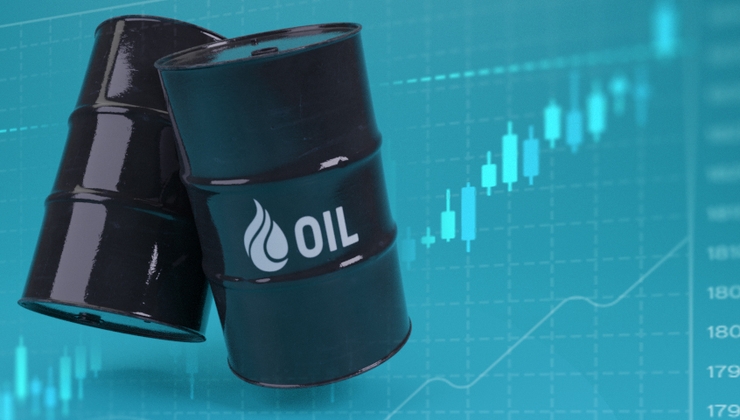- English
- Italiano
- Español
- Français
Dollar Index (DXY):
The market was in wait and see mode while full scale invasion was still an uncertainty. Well that uncertainty has now been made a certainty and the invasion began in the early hours of Thursday morning GMT. Putin desires to demilitarize Ukraine and missile strikes have been targeted towards key Ukrainian military infrastructure. This has led to the typical risk-off playbook being brought out, which saw a spike in the greenback higher off the news. The situation remains fluid and difficult to trade with wild gyrations likely to be the order of the day. Chuck thinner liquidity into the mix and you get big moves. News flow around the war will be the key driver for the dollar, with Fed speakers and data taking a back seat for the time being. Rate pricing for a 50bps hike in March has tumbled significantly to under 20% now.
Despite being completely irrelevant to markets at the moment US GDP for Q4 grew at 7% QoQ annualized (as expected) and PMI data was very solid, indicating strong growth out of the US economy. Price pressures are still present within the PMI data. This is the quandry central banks now find themselves in. Will Ukraine and Russian issues become bad enough to cause a global slowdown while pushing inflation higher (stagflationary environment)? Given we’re at the end of the month, another factor which could help the dollar a tad is month end rebalancing. Dollar buying is what the models are saying should occur.
Late yesterday we saw risk rally and the dollar come off, this trend has continued with risk sentiment remaining strong and the dollar is actually up as well. I think this is due to the Fed being repriced higher again after yesterday’s decline. There are plenty narratives swirling around at the moment as to why we’re seeing a firmer bid into risk assets. I’ll list them 1) Swift restrictions have been left out 2) Dealers large short puts’ positions being unwound (would be buying back stock they were short for hedging purposes) 3) A swifter resolution to the invasion than expected with Ukraine surrendering quickly. Core PCE price data is out at 1.30pm GMT (Fed’s preferred inflation metric). Next week we have Non-Farm Payrolls which will be a biggy before the Fed meeting in mid-March.

(Source: Tradingview - Past performance is not indicative of future performance.)
The technicals show price surged past the key resistance at 96.8 and now sits just above this level. The RSI is in overbought territory, but this can remain overbought or become even more overbought. There is also divergence between price and the RSI taking place. Targets wise on the upside the previous high would need monitoring at 97.6 and on the downside support would be around 96.8 or the 50-day SMA lower at 95.9.
EURUSD:
The single currency has been hit severely hard by the situation in Russia and Ukraine given their reliance on Russian gas (circa 38% of energy imports). Dutch Gas futures have spiked higher. This has created dark storm clouds on the eurozone’s horizon in terms of the economic outlook, with concerns of stagflation rising. Nordstream 2’s certification has been blocked by Germany as one of the sanctions on Russia. The ECB's Holzmann, known for his hawkish views stated that the conflict in Ukraine may delay stimulus exit. This was followed by Isabel Schnabel who said the ECB will carefully evaluate the consequences of the invasion on its policies. In addition she believes inflation is a problem for the eurozone and the labour market is red hot. Nothing new though from her, so nothing to surprise euro traders. €STIRs is now pricing in around 35bps by year end as opposed to 50bps previously.
Another reason driving euro weakness could be the expectation of Russia having to tap its FX reserves due to increasing isolation from global financial markets. Euro makes up the largest holding of its FX reserves. I think in the current climate short EURCHF isn’t a bad trade either to have on the radar. Flash PMI for Eurozone and Germany beat on services, but not manufacturing. Prices paid rising as a result of wage and energy bills, indicating inflationary pressures are not subsiding. German Ifo data was robust with current conditions and expectations outperforming forecasts as well as the previous month’s print. Q4 GDP data out from Germany was better than expected with a QoQ figure decline of -0.3% vs -0.7% expected. Next week sees flash eurozone inflation data dropping on Wednesday. ECB Chief Economist Lane today informed the market he believes the Ukrainian invasion may shave off 0.3-0.4% off eurozone 2022 GDP in a middle scenario.

(Source: Tradingview - Past performance is not indicative of future performance.)
When you get left-tail risk shocks the technicals can be blow right out. We see this with EURUSD as price sliced right through the bottom of support at 1.125. Could we be seeing a double bottom forming here at the 1.11 area. The RSI nears oversold territory, but is not quite there yet. Targets wise, on the downside a test of the former lows at 1.11 would be important and on the upside former support at 1.125 could cap further gains.
GBPUSD:
Cable had been trying to hang in there, but completely collapsed on Thursday as once again GBP lived up to its title of a risk sensitive currency. GBPUSD fell over 300 pips today, hitting a low of 1.3272 intraday. Flash PMIs were solid and endorses the good growth momentum for the UK economy as omicron fades into memory. Beat expectations across manufacturing and services. Prices paid component rising again similar to Europe – wage pressures and energy bills are driving inflationary pressures. Prime Minister Johnson has decided to scrap remaining covid restrictions in England, with masks no longer being necessary in public transport and self-isolation for a positive test being removed.
UK is rolling out tough sanctions on Russia and is pushing for cutting Russia off from SWIFT, disappointingly Germany has rejected calls for this. It may not change Putin’s current course, but it would certainly cause the Russian economy far more pain than the current set of sanctions. Gov Bailey testified to the Treasury Committee about inflation. He informed those listening that the BoE are mostly united on the BoE’s terminal rate, but where they differ is on the speed of reaching that rate – i.e. front-loaded fast or slower more gradual pace. He also said the market shouldn’t get carried away with rate hikes. Usually a governor would hope their jawboning would result in the rates market repricing lower, but this repricing lower is all due to conflict in the East.

(Source: Tradingview - Past performance is not indicative of future performance.)
Big wicks on the candles highlight the intra-day volatility currently playing out. Price got down to a low of 1.327 yesterday and has now recovered to near 1.34 (around the 61.8% Fibonacci level). The RSI is near to oversold and looks to have turned upwards. Targets wise, The 50% Fibonacci level at 1.347 is one to have on your radar, while to the downside the former low at 1.327 would be key.
USDJPY:
This cross remains rangebound as the dollar and yen jockey for pole position as the safe haven of choice. However, Japan is a massive oil net importer and may get hurt from major spikes in crude, providing the dollar with the slight edge. Given it was PMI week for the G4, it’s worth mentioning Japan’s PMI for February came through very soft. Well below expectations as well as previous month’s figures. I still like USDJPY higher as a US rates proxy if the geopolitical tensions eventually resolve and don’t cause longer-term scarring effects. Short EURJPY is probably the easier directional trade to have more conviction about in the current climate.

(Source: Tradingview - Past performance is not indicative of future performance.)
Potential double top (shaded circles) playing out on USDJPY. The RSI is in no man’s land so no informational advantage can be gleaned from this. Price is right on the resistance line of 115.5. Targets on the upside would be the highs of the double top circles and on the downside the middle of the range support at 114.5.
Gold:
Gold remains completely at the whims of geopolitical tensions. Yesterday’s price move was something to behold. $2000 certainly was in reach as price spike up to $1975. I’m sure some profit taking likely took place up at those lofty levels after such a strong run and the rally back in risk would have caused the roundtrip price action. Also, given Russia’s substantial accumulation of gold reserves, this could be making some nervous about significant supply potentially hitting the market. Trade gold against the weakest currency for example gold/euro as you’ll get the kicker from the weaker currency as well as the appreciation in the gold price.

(Source: Tradingview - Past performance is not indicative of future performance.)
Gold technicals are like a yo-yo at the moment. Price got close to $2000, but has now rapidly slumped. There looks to be minor support at $1890-95. If shorts push it below here we could see price get down to the 21-day EMA around $1870. On the upside, $1915 is a good initial level to monitor. The RSI is back to the key former resistance level of 62.8, will it now act as support? The % above/below the 50-day SMA pane at the bottom has begun to rollover from the 4.5 peak we saw around November too.
Crude:
Another asset caught in the crosshairs of conflict. There is a substantial risk premium being priced into oil markets – I’d say anywhere from about $10-15 a barrel. The big news yesterday was a breach of the key psychological level of $100 a barrel. The two main themes driving crude at the moment remain the above and nuclear negotiations with Iran, pulling price in opposite directions. The former is definitely exerting a larger magnet effect than the latter. We have another OPEC+ meeting next week Wednesday, where the expectation is for the release of 400k bpd. US inventory data showed a significant build up in inventory (much larger than expected), but oil bulls shrugged this off.

(Source: Tradingview - Past performance is not indicative of future performance.)
Spot brent is coming off quite a bit today with the risk picture a bit more optimistic. The RSI is rolling over from overbought and heading south. $95 would be the key support level for further sell-offs, while on the upside $100 remains important. The 21-day EMA has worked very well as a dynamic trailing support.
Related articles
Ready to trade?
It's quick and easy to get started. Apply in minutes with our simple application process.
The material provided here has not been prepared in accordance with legal requirements designed to promote the independence of investment research and as such is considered to be a marketing communication. Whilst it is not subject to any prohibition on dealing ahead of the dissemination of investment research we will not seek to take any advantage before providing it to our clients.
Pepperstone doesn’t represent that the material provided here is accurate, current or complete, and therefore shouldn’t be relied upon as such. The information, whether from a third party or not, isn’t to be considered as a recommendation; or an offer to buy or sell; or the solicitation of an offer to buy or sell any security, financial product or instrument; or to participate in any particular trading strategy. It does not take into account readers’ financial situation or investment objectives. We advise any readers of this content to seek their own advice. Without the approval of Pepperstone, reproduction or redistribution of this information isn’t permitted.
.jpg)

